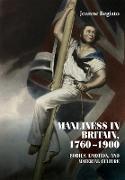- Start
- Manliness in Britain, 1760–1900
Manliness in Britain, 1760–1900
Angebote / Angebote:
Manliness in Britain offers a new account of masculinity in the long nineteenth century: more corporeal and material, more emotional, more cross-class, and less heteronormative than other studies. Using diverse textual, visual, and material culture sources, it shows that masculinities were produced and disseminated through men's bodies - very often working-class ones - and the emotions and material culture associated with them.
The book disrupts the chronology of nineteenth-century masculinities, since it stretches from the ages of feeling, revolution, and reform to those of militarism, imperialism, representative democracy, and mass media. It also queers these histories, by recognising that male and female desire for idealised male bodies and the gender attributes they represented was integral to the success of manliness. Imagined working-class men such as soldiers, sailors, and industrial workers were central to broader ideas of manliness and unmanliness. They not only offered didactic lessons for the working classes and made the labouring ranks appear less threatening, they also provide insights into the production of middle-class men's identities.
The book shows that this melding of bodies, emotions, and material culture created emotionalised bodies and objects, which facilitated the conveying, reproducing, and fixing of manliness in society. As such, it will be vital for students and academics in the history of bodies, emotions, gender, and material culture.
Folgt in ca. 10 Arbeitstagen
